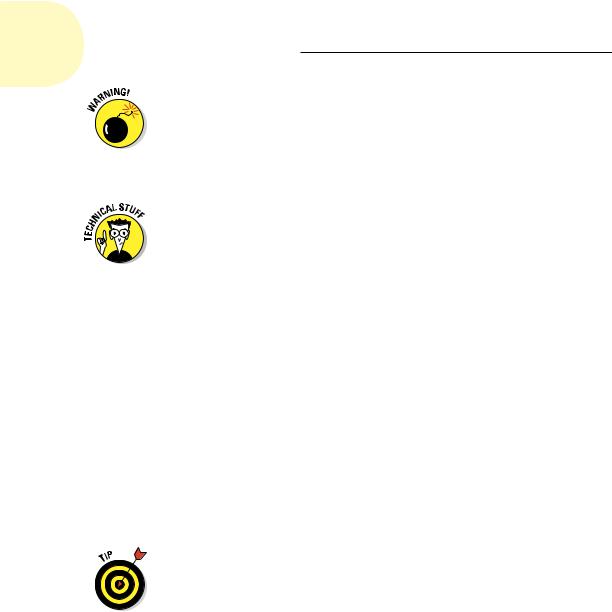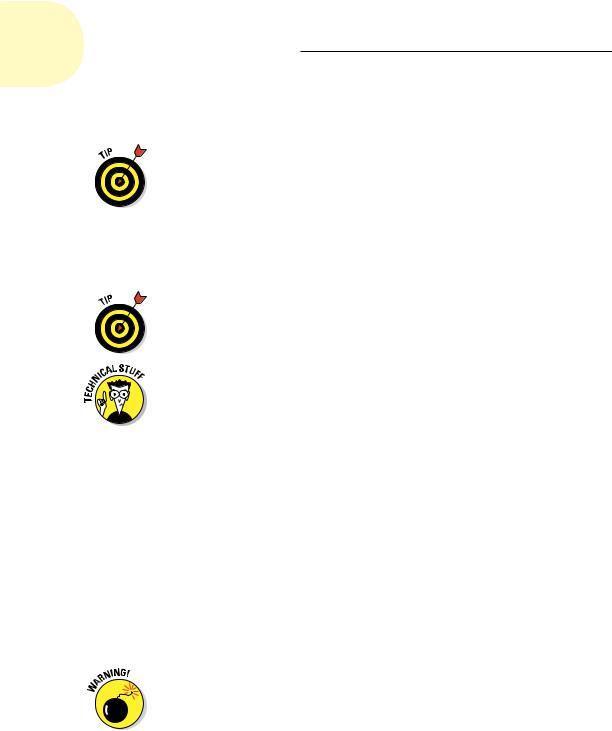
- •About the Authors
- •Dedication
- •Authors’ Acknowledgments
- •Table of Contents
- •Introduction
- •What’s Not (And What Is) in This Book
- •Mac attack!
- •Who Do We Think You Are?
- •How This Book Is Organized
- •Part I: AutoCAD 101
- •Part II: Let There Be Lines
- •Part III: If Drawings Could Talk
- •Part IV: Advancing with AutoCAD
- •Part V: On a 3D Spree
- •Part VI: The Part of Tens
- •But wait . . . there’s more!
- •Icons Used in This Book
- •A Few Conventions — Just in Case
- •Commanding from the keyboard
- •Tying things up with the Ribbon
- •Where to Go from Here
- •Why AutoCAD?
- •The Importance of Being DWG
- •Seeing the LT
- •Checking System Requirements
- •Suddenly, It’s 2013!
- •AutoCAD Does Windows (And Office)
- •And They’re Off: AutoCAD’s Opening Screens
- •Running with Ribbons
- •Getting with the Program
- •Looking for Mr. Status Bar
- •Let your fingers do the talking: The command window
- •The key(board) to AutoCAD success
- •Keeping tabs on palettes
- •Down the main stretch: The drawing area
- •Fun with F1
- •A Simple Setup
- •Drawing a (Base) Plate
- •Drawing rectangles on the right layers
- •Circling your plate
- •Nuts to you
- •Getting a Closer Look with Zoom and Pan
- •Modifying to Make It Merrier
- •Hip-hip-array!
- •Stretching out
- •Crossing your hatches
- •Following the Plot
- •A Setup Roadmap
- •Choosing your units
- •Weighing up your scales
- •Thinking annotatively
- •Thinking about paper
- •Defending your border
- •A Template for Success
- •Making the Most of Model Space
- •Setting your units
- •Making the drawing area snap-py (and grid-dy)
- •Setting linetype and dimension scales
- •Entering drawing properties
- •Making Templates Your Own
- •Setting Up a Layout in Paper Space
- •Will that be tabs or buttons?
- •View layouts Quick(View)ly
- •Creating a layout
- •Copying and changing layouts
- •Lost in paper space
- •Spaced out
- •A view(port) for drawing in
- •About Paper Space Layouts and Plotting
- •Managing Your Properties
- •Layer one on me!
- •Accumulating properties
- •Creating new layers
- •Manipulating layers
- •Using Named Objects
- •Using AutoCAD DesignCenter
- •Copying layers between drawings
- •Controlling Your Precision
- •Keyboard capers: Coordinate input
- •Understanding AutoCAD’s coordinate systems
- •Grab an object and make it snappy
- •Other Practical Precision Procedures
- •Introducing the AutoCAD Drawing Commands
- •The Straight and Narrow: Lines, Polylines, and Polygons
- •Toeing the line
- •Connecting the lines with polyline
- •Squaring off with rectangles
- •Choosing your sides with polygon
- •(Throwing) Curves
- •Going full circle
- •Arc-y-ology
- •Solar ellipses
- •Splines: The sketchy, sinuous curves
- •Donuts: The circles with a difference
- •Revision clouds on the horizon
- •Scoring Points
- •Commanding and Selecting
- •Command-first editing
- •Selection-first editing
- •Direct object manipulation
- •Choosing an editing style
- •Grab It
- •One-by-one selection
- •Selection boxes left and right
- •Perfecting Selecting
- •AutoCAD Groupies
- •Object Selection: Now You See It . . .
- •Get a Grip
- •About grips
- •A gripping example
- •Move it!
- •Copy, or a kinder, gentler Move
- •A warm-up stretch
- •Your AutoCAD Toolkit
- •The Big Three: Move, Copy, and Stretch
- •Base points and displacements
- •Move
- •Copy
- •Copy between drawings
- •Stretch
- •More Manipulations
- •Mirror
- •Rotate
- •Scale
- •Array
- •Offset
- •Slicing, Dicing, and Splicing
- •Trim and Extend
- •Break
- •Fillet and Chamfer and Blend
- •Join
- •When Editing Goes Bad
- •Zoom and Pan with Glass and Hand
- •The wheel deal
- •Navigating your drawing
- •Controlling your cube
- •Time to zoom
- •A View by Any Other Name . . .
- •Looking Around in Layout Land
- •Degenerating and Regenerating
- •Getting Ready to Write
- •Simply stylish text
- •Taking your text to new heights
- •One line or two?
- •Your text will be justified
- •Using the Same Old Line
- •Turning On Your Annotative Objects
- •Saying More in Multiline Text
- •Making it with Mtext
- •It slices; it dices . . .
- •Doing a number on your Mtext lists
- •Line up in columns — now!
- •Modifying Mtext
- •Gather Round the Tables
- •Tables have style, too
- •Creating and editing tables
- •Take Me to Your Leader
- •Electing a leader
- •Multi options for multileaders
- •How Do You Measure Up?
- •A Field Guide to Dimensions
- •The lazy drafter jumps over to the quick dimension commands
- •Dimension associativity
- •Where, oh where, do my dimensions go?
- •The Latest Styles in Dimensioning
- •Creating and managing dimension styles
- •Let’s get stylish!
- •Adjusting style settings
- •Size Matters
- •Details at other scales
- •Editing Dimensions
- •Editing dimension geometry
- •Editing dimension text
- •Controlling and editing dimension associativity
- •Batten Down the Hatches!
- •Don’t Count Your Hatches. . .
- •Size Matters!
- •We can do this the hard way. . .
- •. . . or we can do this the easy way
- •Annotative versus non-annotative
- •Pushing the Boundary (Of) Hatch
- •Your hatching has no style!
- •Hatch from scratch
- •Editing Hatch Objects
- •You Say Printing, We Say Plotting
- •The Plot Quickens
- •Plotting success in 16 steps
- •Get with the system
- •Configure it out
- •Preview one, two
- •Instead of fit, scale it
- •Plotting the Layout of the Land
- •Plotting Lineweights and Colors
- •Plotting with style
- •Plotting through thick and thin
- •Plotting in color
- •It’s a (Page) Setup!
- •Continuing the Plot Dialog
- •The Plot Sickens
- •Rocking with Blocks
- •Creating Block Definitions
- •Inserting Blocks
- •Attributes: Fill-in-the-Blank Blocks
- •Creating attribute definitions
- •Defining blocks that contain attribute definitions
- •Inserting blocks that contain attribute definitions
- •Edit attribute values
- •Extracting data
- •Exploding Blocks
- •Purging Unused Block Definitions
- •Arraying Associatively
- •Comparing the old and new ARRAY commands
- •Hip, hip, array!
- •Associatively editing
- •Going External
- •Becoming attached to your xrefs
- •Layer-palooza
- •Creating and editing an external reference file
- •Forging an xref path
- •Managing xrefs
- •Blocks, Xrefs, and Drawing Organization
- •Mastering the Raster
- •Attaching a raster image
- •Maintaining your image
- •Theme and Variations: Dynamic Blocks
- •Lights! Parameters!! Actions!!!
- •Manipulating dynamic blocks
- •Maintaining Design Intent
- •Defining terms
- •Forget about drawing with precision!
- •Constrain yourself
- •Understanding Geometric Constraints
- •Applying a little more constraint
- •AutoConstrain yourself!
- •Understanding Dimensional Constraints
- •Practice a little constraint
- •Making your drawing even smarter
- •Using the Parameters Manager
- •Dimensions or constraints — have it both ways!
- •The Internet and AutoCAD: An Overview
- •You send me
- •Send it with eTransmit
- •Rapid eTransmit
- •Bad reception?
- •Help from the Reference Manager
- •Design Web Format — Not Just for the Web
- •All about DWF and DWFx
- •Autodesk Design Review 2013
- •The Drawing Protection Racket
- •Autodesk Weather Forecast: Increasing Cloud
- •Working Solidly in the Cloud
- •Free AutoCAD!
- •Going once, going twice, going 123D
- •Your head planted firmly in the cloud
- •The pros
- •The cons
- •Cloudy with a shower of DWGs
- •AutoCAD 2013 cloud connectivity
- •Tomorrow’s Forecast
- •Understanding 3D Digital Models
- •Tools of the Trade
- •Warp speed ahead
- •Entering the third dimension
- •Untying the Ribbon and opening some palettes
- •Modeling from Above
- •Using 3D coordinate input
- •Using point filters
- •Object snaps and object snap tracking
- •Changing Planes
- •Displaying the UCS icon
- •Adjusting the UCS
- •Navigating the 3D Waters
- •Orbit à go-go
- •Taking a spin around the cube
- •Grabbing the SteeringWheels
- •Visualizing 3D Objects
- •Getting Your 3D Bearings
- •Creating a better 3D template
- •Seeing the world from new viewpoints
- •From Drawing to Modeling in 3D
- •Drawing basic 3D objects
- •Gaining a solid foundation
- •Drawing solid primitives
- •Adding the Third Dimension to 2D Objects
- •Creating 3D objects from 2D drawings
- •Modifying 3D Objects
- •Selecting subobjects
- •Working with gizmos
- •More 3D variants of 2D commands
- •Editing solids
- •Get the 2D Out of Here!
- •A different point of view
- •But wait! There’s more!
- •But wait! There’s less!
- •Do You See What I See?
- •Visualizing the Digital World
- •Adding Lighting
- •Default lighting
- •User-defined lights
- •Sunlight
- •Creating and Applying Materials
- •Defining a Background
- •Rendering a 3D Model
- •Autodesk Feedback Community
- •Autodesk Discussion Groups
- •Autodesk’s Own Bloggers
- •Autodesk University
- •The Autodesk Channel on YouTube
- •The World Wide (CAD) Web
- •Your Local ATC
- •Your Local User Group
- •AUGI
- •Books
- •Price
- •3D Abilities
- •Customization Options
- •Network Licensing
- •Express Tools
- •Parametrics
- •Standards Checking
- •Data Extraction
- •MLINE versus DLINE
- •Profiles
- •Reference Manager
- •And The Good News Is . . .
- •APERTURE
- •DIMASSOC
- •MENUBAR
- •MIRRTEXT
- •OSNAPZ
- •PICKBOX
- •REMEMBERFOLDERS
- •ROLLOVERTIPS
- •TOOLTIPS
- •VISRETAIN
- •And the Bonus Round
- •Index

Chapter 14: Entering New Dimensions 311
The system variable MEASUREMENT can be used to override the default for a specific drawing, but it affects only text, hatching, and noncontinuous line types.
Let’s get stylish!
The following steps describe how to create your own dimension style(s):
1.On the Ribbon’s Home tab, click the label of the Annotation panel to open the panel slideout, and then click the Dimension Style button.
Alternatively, if that just sounds like too much work, you could type D and press Enter. The Dimension Style Manager dialog box appears.
2.In the Styles list, select the existing dimension style whose settings you want to use as the starting point for the settings of your new style.
For example, select the default dimension style named Standard or ISO-25.
3.Click the New button to create a new dimension style that’s a copy of the existing style.
The Create New Dimension Style dialog box appears.
4.Enter a New Style Name and then select or deselect the Annotative check box. Click Continue.
Select the Annotative check box to create an annotative dimension style, or deselect it for a non-annotative style. Refer to Chapter 13 and later in this chapter for more about annotative objects.
The New Dimension Style dialog box appears. (This dialog box is virtually identical to the Modify Dimension Style dialog box.)
5.Modify dimension settings on any of the seven tabs in the New Dimension Style dialog box.
See the descriptions of these settings in the next section of this chapter.
6.Click OK to close the New Dimension Style dialog box.
The Dimension Style Manager dialog box reappears.
7.Click Close.
The Dimension Style Manager dialog box closes, and your new dimension style becomes the current dimension style that AutoCAD uses for future dimensions in this drawing.
8.Draw some dimensions to test your new dimension style.
www.it-ebooks.info

312 Part III: If Drawings Could Talk
Avoid changing existing dimension styles that you didn’t create unless you know for sure what they’re used for. When you change a dimension style setting, all existing dimensions that use that style change to reflect the revised setting. Thus, one small dimension variable setting change can affect a large number of existing dimensions! To play it safe, instead of modifying an existing dimension style, create a new style by copying an existing one and modifying the new one.
A further variation on the already convoluted dimension styles picture is that you can create dimension substyles (also called style families), which are variations of a main style that affect only a particular type of dimension, such as radial or angular. If you open the Dimension Style Manager dialog box and see names of dimension types indented beneath the main dimension style names, be aware that you’re dealing with substyles.
Adjusting style settings
After you click New or Modify in the Dimension Style Manager dialog box, AutoCAD displays a tabbed New Dimension Style or Modify Dimension Style dialog box (the two dialog boxes are identical except for the title bar) with a mind-boggling — and potentially drawing-boggling, if you’re not careful — array of settings.
Fortunately, the dimension preview that appears on all tabs — as well as on the main Dimension Style Manager dialog box — immediately shows the results of most setting changes. With the dimension preview and some trial- and-error changing of settings, you can usually home in on an acceptable group of settings. For more information, use the dialog box help feature: Just hover your mouse pointer over the setting that you want to know more about.
Before you start messing with dimension style settings, it’s important to know what you want your dimensions to look like when they’re plotted. If you’re not sure how it’s done in your industry, ask others in your office or profession, or look at a plotted drawing that someone in the know represents as being a good example. A general rule we’ve found to be helpful in virtually all aspects of life is to stick with the defaults unless you know specifically what you want to change — and why.
The following sections introduce you to the more important tabs in the New/ Modify Dimension Style dialog boxes and highlight useful settings. Note that whenever you specify a distance or length setting, you should enter the desired plotted size. We discuss plotting size scale factors in Chapters 13 (text) and 15 (hatching), and later in this chapter.
www.it-ebooks.info

Chapter 14: Entering New Dimensions 313
Following lines and arrows
The settings on the Lines tab and the Symbols and Arrows tab control the basic look and feel of all parts of your dimensions, except text.
Symbolically speaking
The settings on the Symbols and Arrows tab control the shape and appearance of arrowheads and other symbols.
A useful setting is Center Marks. Depending on which radio button you select, placing a radius or diameter dimension will also identify the center by placing a small center mark, or center lines that extend just beyond the circle or arc, or none. The default is tick marks, but we prefer lines because normal drafting practice is usually to show center lines.
Tabbing to text
Use the Text tab to control how your dimension text looks — the text style and height to use (see Chapter 13) and where to place the text with respect to the dimension and extension lines. In particular, note the Text Style dropdown, which contains a list of the text styles available in the drawing. The three-dot button at the right end of the list gives direct access to the text style dialog box so you can edit or create a suitable text style if one doesn’t already exist in your current drawing. See Chapter 13 for more information on text styles. The default Text Height in imperial units is too large for most situations — set it to 1/8", 3mm, or another height that makes sense.
Even if you’re opposed to defacing books, get out a bright red marker and put a circle around this warning, even if you borrowed the book from the library or a friend. Here goes: You must define the text style that you specify for a dimension style with a height of 0 (zero) in the Text Style dialog box. (See Chapter 13 for more information about variable-height and fixed-height text styles.) If you specify a fixed-height text style for a dimension style, the text style’s height will override the Text Height setting in the New/Modify Dimension Style dialog boxes. Use a zero-height style to avoid the problem — and bear in mind that using nonzero-height text styles in dimensions is one of the most common mistakes made by new AutoCAD users.
Getting fit
The Fit tab includes a bunch of options that control when and where AutoCAD shoves the dimension text if it doesn’t quite fit between the extension lines. The default settings leave AutoCAD in “maximum attempt at being helpful” mode — that is, AutoCAD moves the text, dimension lines, and arrows around automatically so that things don’t overlap. On rare occasions, AutoCAD’s guesses might be less than perfect. It’s usually easier to adjust the
www.it-ebooks.info

314 Part III: If Drawings Could Talk
text placement by grip editing the placed dimension, as we describe in the section “Editing dimension geometry,” later in this chapter, instead of messing with dimension style settings.
Even at its most helpful, AutoCAD sometimes makes a bad first guess about how you want your dimension text and arrows arranged. If you’re having problems getting the look you want, don’t flip your wig — flip your arrows to the other side of the dimension lines by selecting the dimension and choosing Flip Arrow from the multifunction grip on the arrow.
Most important, the Fit tab includes the Annotative check box. Using annotative dimensions, as we recommend in this chapter, will make your dimensioning go a lot more smoothly!
We highly recommend that you get comfortable with annotative dimensioning in model space. Unfortunately, old-style (that is, non-annotative) dimensioning is still part of the program, and many offices will probably keep doing it that way for a while to come.
The Use Overall Scale Of setting corresponds to the DIMSCALE system variable, and you’ll hear long-time AutoCAD drafters refer to it as such. In Chapters 13 (text) and 15 (hatching), we refer to a scale factor by which text height and hatch patterns need to be multiplied so they plot properly. This also applies to dimensions. If you are using old-style non-annotative dimensions, this is where that number goes. It resizes text height, arrowhead sizes, and gaps accordingly. When Scale Dimensions to Layout (for paper space layout dimensioning) is selected, DIMSCALE is automatically set to 0 (zero). When Annotative is selected, DIMSCALE is ignored, and a suitable scale factor is applied to each dimension when it’s created.
Using primary units
The Primary Units tab gives you highly detailed control over how AutoCAD formats the characters in the dimension text string. You usually want to set the Unit format and Precision and maybe specify a suffix for unitless numbers if it’s not clear from your drawing what units you’re using. You may also change the Zero Suppression settings, depending on whether you want dimension text to read 0.5000, .5000, or 0.5. (“Zero Suppression!” also makes a great rallying cry for organizing your fellow AutoCAD drafters.)
AutoCAD 2010 introduced an interesting tweak to dimension text: Dimension subunits. If the main unit of measure on your drawing is meters — rather than have a bunch of smaller distances dimensioned as, say, 0.450 — you could create a centimeter subunit so that any dimension of less than 1 meter would be shown in centimeters. We were always taught a very strict drafting standard that says that all dimensions on a drawing must be in the same units. In other words, in a drawing with meters as the dimension unit, 0.45 would
www.it-ebooks.info
